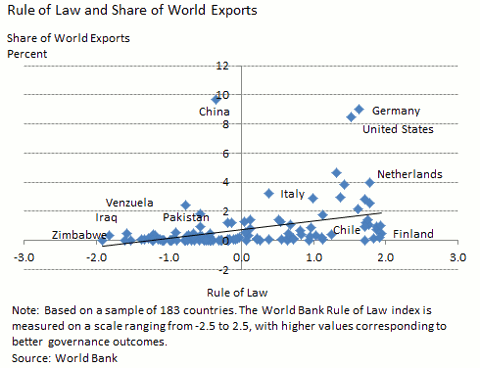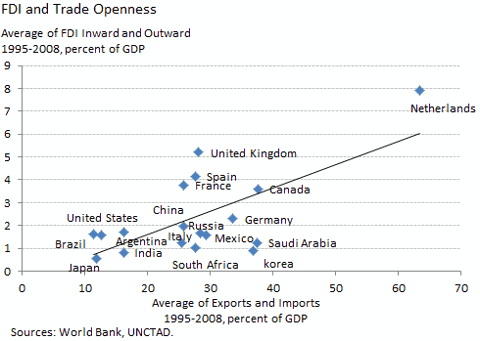Why Is Protectionism Dormant?
Though countries enacted hundreds of protectionist measures during the global financial crisis, only a small part of world trade ― just 0.8 percent between October 2008 and October 2009 — was affected. Even the most frequent targets of trade-discriminatory measures, such as China, and perpetrators including India, saw export and import trends change little, respectively, during the crisis.
Moreover, the impact appears to have subsided quickly: The share of world trade affected by protectionist measures from May to October 2010 fell to 0.2 percent and world trade flows surpassed pre-crisis levels in 2010.
But protectionism is not dead yet, as evidenced by its increase during the crisis, the rise in protectionist measures in the past six months, and the high barriers to trade that persist across large sectors. And, with the legacy of the last crisis, governments are now more vulnerable than before to the resurgence of protectionism if another global crisis strikes. It is therefore essential to understand the forces that helped limit protectionism during the last crisis.
What were they? In contrast to the 1930s, efforts to contain the depth and duration of the recession such as concerted stimulus measures by G20, as well as flexible exchange rates, helped countries adjust without resorting to extensive protectionism. Social safety nets alleviated the effects of recession. World Trade Organization (WTO) disciplines, which are enforceable through its Dispute Settlement Mechanism (DSM), also helped to curb protectionism, though their applicability is limited across large swaths of trade — including services, agriculture, and manufactured imports in developing countries — and they do not prevent countries from using safeguarding and antidumping provisions to justify protectionism.
Less noticed and probably even more important, the embedding of liberalization in difficult-to-change national laws and the spread of regional agreements — as well as structural shifts that increased the role of trade in production and in consumption — deter protectionism.
National Disciplines
Autonomous liberalization has accounted for the bulk of trade liberalization in developing countries over the last three decades and also played a large role in advanced countries. The enactment of a liberal trading environment with strong legal institutions inspires confidence among importers and exporters in a country’s trading environment. This is particularly true where the rule of law is strong.
As shown in the chart below, though not necessarily demonstrating causality, a country’s share of world trade is positively and significantly correlated to its score on the World Bank’s Rule of Law index, indicating a potential relationship between the strength of its legal infrastructure and its capacity to conduct trade. Given that the rule of law is strong in countries that account for the lion’s share of world trade (China is a partial exception, with its low rule of law score), the world trading environment has clearly become safer and more predictable.
[Click all to enlarge]
In addition, national laws affecting trade are often difficult to change. Because most of the largest traders have enacted laws that liberalize trade, this is good news for those that hope to limit protectionism. In the United States, for example, a permanent tariff increase (even if allowed by the WTO) would require passage by majorities in the Senate and the House of Representatives, as well as the president’s signature. Procedures in the European Union are arguably even more elaborate.
Temporary protectionist measures, such as antidumping and countervailing duties, as well as safeguarding measures, are also hard to enact. The introduction of national trade tribunals has given firms a mechanism through which they can contest trade measures. In the United States, for example, the Department of Commerce and the International Trade Commission (USITC) are bound to conduct detailed investigations that ask potentially affected domestic and foreign firms about their trade practices. Foreign companies that participate in the process have generally face lower-than-average duties.
Many national governments have developed mechanisms to ensure that trade policy reflects the general interest. For example, U.S. trade officials often lobby congress against protectionist bills, and pro-trade bureaucratic interests in China (centered in the Ministry of Commerce) promote the adoption of international practices, including trade liberalization. The Australian Productivity Commission, which produces periodic reports on the economy-wide effects of trade barriers through an open, multi-stakeholder process is another example.
Regional Trade Agreements
In addition to national processes, regional trade agreements (RTAs) ― which now cover about 60 percent of world trade in goods ― help limit protectionism. RTAs contain provisions establishing dispute settlement mechanisms (DSMs) that enable countries to challenge violations of the agreements, thereby combating protectionism.
The NAFTA DSM, for example — which reviews cases of antidumping and countervailing duties — has often lowered U.S. trade remedies against Canada and Mexico. Countries rarely use these DSMs, which may in part reflect the clarity of RTAs, which are made among a small number of partners and provide for free trade across the vast majority of products.
Furthermore, RTAs often establish regular, high-level dialogues on trade disputes, treaty implementation, and further liberalization. Such forums provide another mechanism for resolving serious violations of the agreement. The EU-Mexico Free Trade Agreement, for example, established a joint council that meets every other year to discuss a wide range of strategic issues, including trade-related concerns. Some countries without bilateral trade treaties have also established regular high-level dialogues, such as the United States-China Joint Commission on Commerce and Trade, which furnish a direct diplomatic channel for resolving trade disputes and discussing further liberalization.
“Facts on the Ground”
With the growth and increased granularity of trade, import-competing sectors no longer hold the bulk of political power in domestic protectionism debates. Some of the most vulnerable import-competing sectors in advanced countries, such as garments and footwear, have become much smaller, while exporters have become larger. Meanwhile, large investments have been made assuming that the free trade regime will continue; the longer the regime persists, the larger these investments and the greater the vested interest in it. And retailers and consumers have come to rely on imports. The internationalization of production and the rise of intra-firm trade have also added voices favoring trade liberalization to the debate.
Imports also add significant value domestically through distribution, marketing, and retail. Distribution margins such as retail trade and transportation costs account for about 20 percent of purchasers’ prices in many advanced economies. In addition, large and politically powerful companies, ranging from retailers to shippers, have come to depend on imports for which comparably priced domestic goods are unavailable.
For example, a third of U.S. imports of textiles and apparel come from China. If high tariffs were enacted, increasing the cost of such imports, the profitability of firms that depend on them would be in danger; predictably, these firms lobby against trade barriers. The growing consumer preference for varied goods, often satisfied through imports, adds to the resistance to impose higher tariffs.
Furthermore, many firms have come to rely on international supply chains, which include imports of input components for production and exports of such materials to foreign manufacturers. Imports of components now represent more than half the imports of OECD countries and three-fourths of the imports of China and Brazil.
According to OECD estimates, imported intermediate content accounted for about a quarter of OECD economies’ exports in 2005. Thus, any initiative to increase protection across the board may penalize exporters both directly (through the higher prices of imported components) and indirectly (through possible retaliation from trading partners). As a result, firms that produce and trade intermediate goods view protectionism as a direct threat to their production chain, market access, and, ultimately, profitability. Many countries, such as Mexico, have implemented policies that give exporters duty-free access to imported intermediates.
Moreover, due to the rise of intra-firm trade ― which amounted to about 40 percent of total U.S. trade over the past 10 years ― much of the cost of raising tariffs on parts and components is directly borne by domestic companies. In other words, the protection that occurs is effectively against a country’s own firms, which can make countries more reluctant to erect trade barriers.
The fierce global competition for foreign direct investment (FDI) is now also believed to discourage protectionism. More open economies generally enjoy higher FDI, as shown in the figure below, as foreign subsidiaries are better able to serve their purposes — including distribution, marketing, and production for home and foreign markets (which often rely on imported components) — in countries with more open and predictable trading regimes.
Policy
In addition to good macroeconomic and social policy, which helped contain the recession’s duration and depth, assuring open markets requires a more realistic approach to trade negotiation. Such an approach must embrace plurilateral, bilateral, and regional processes to maintain the momentum of change.
For the WTO to remain relevant, it must view itself as the facilitator of these processes, and of autonomous liberalization, rather than only as a forum for the exchange of multilateral concessions. Domestic forces that oppose protectionism should be mobilized more systematically, as is done under the Australian Productivity Commission, to ensure transparent examination of trade protection proposals by broad constituencies.
In an interconnected world, policy makers must also pay increased attention to trade facilitation to lower trade costs, thus creating more “facts on the ground” in the form of investments that are predicated on trade and consolidating political support for liberal trade polices. These measures will help foster a liberal trade environment and further strengthen the resistance to protectionism.


Không có nhận xét nào:
Đăng nhận xét